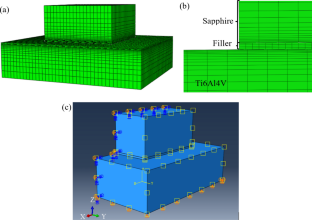Residual stress is a key factor affecting the properties of ceramic/metal brazed joints. In this work, the residual stress of sapphire/Ti6Al4V alloy joints brazed with CuTi+B composite filler after cooling and reheated to 400 °C was calculated by finite element numerical simulation method. The effect of the B content in the filler and the filler thickness on the residual stress distribution of brazed joints after cooling was studied. The results show that the residual stress is mainly concentrated in the area near the filler layer. The maximum von Mises stress is located in the filler layer and a large Z-axial (the direction perpendicular to the brazed surface) tensile stress is on the sapphire near the filler layer. The B content and the filler thickness have no significant effect on the distribution of residual stress, but they have a certain effect on the value of residual stress of the sapphire near the filler layer. The von Mises stress and the Z-axial stress of this area increase with the increase of B content, and they decrease first and then increases with the increase of filler thickness. When the sapphire/Ti6Al4V joint is reheated to 400 °C, its residual stress significantly reduces and the residual stress on the periphery of the filler layer changes from compressive stress to tensile stress. As the B content is 1 and 3 wt%, the sapphire/Ti6Al4V joint with a smaller residual stress can be obtained. The microstructure observation and shear tests of the joints show that cracks appear in the high stress concentration area and the fracture starts from the area with maximum axial tensile stress, which verifies the accuracy of the simulation results.



